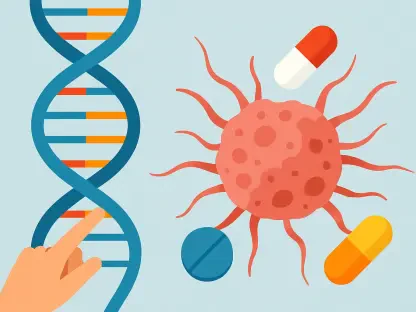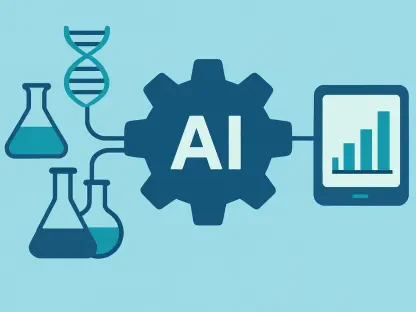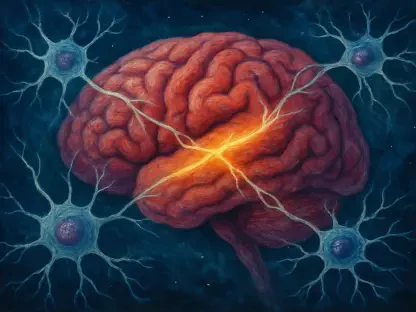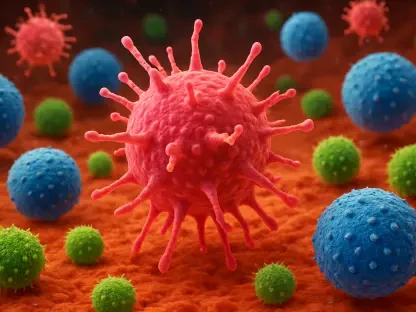At the crossroads of artificial intelligence and biology lies a transformative opportunity poised to redefine the boundaries of medical science. The GREmLN initiative, spearheaded by the Chan Zuckerberg Initiative in collaboration with New York Biohub, aims to bridge these two disciplines in a manner that not only enhances scientific understanding but also propels forward the possibilities of precision medicine. This endeavor is part of a larger shift toward integrating AI models with biological frameworks to capture complex cellular interactions, with the prospect of transitioning from theoretical models to real-world clinical applications. As technologies continue to evolve, the promise of having AI systems interpret and map intricate biological networks is drawing closer, heralding an era where diseases once perceived as incurable might be met with innovative solutions.
The Challenge of Modeling Biological Complexity
Biological systems are governed by complex, multilayered networks, much like the narrative intricacies depicted in fictional stories where seemingly minor elements can precipitate major transformations. In nature, cells communicate through highly dynamic regulatory networks composed of genes, proteins, and signaling pathways engaging in constant interaction. These interactions defy linear predictability and require a nuanced understanding that challenges traditional AI models, typically used for interpreting structured and patterned data.
Classical AI frameworks, such as those seen in language processing models like ChatGPT, are adept at processing and analyzing ordered data using syntactic and contextual cues. However, when transposed to the realm of cellular biology, these models face significant hurdles, particularly in deciphering the causality-laden and loop-contained processes inherent to biological systems. Traditional AI’s difficulty with adapting to this complexity stems chiefly from its design, which often lacks the capability to manage intricate causal relationships that are central to understanding cellular mechanisms.
Traditional models suffer from some core limitations that impede their success in biology. Dr. Andrea Califano, a leading figure in systems biology and the founding director of CZ Biohub New York, delineates these limitations as an absence of causal attention, difficulty negotiating recursive networks within cells, and constraints in adapting a sequential understanding to the ever-changing landscapes of cellular interactions. Consequently, there is a pressing need to transcend these barriers, necessitating approaches like GREmLN that inherently incorporate biological logic into their functional design.
The GREmLN Initiative: Integrating Biological Logic
In response to the challenges posed by traditional AI systems, the development of GREmLN represents a shift toward embedding biological intelligence directly within the AI framework. Unlike conventional AI methods that impose preset programming logic onto biological systems, GREmLN functions by embedding the regulatory rules governing biological interactions into its model. This innovative approach involves encoding dynamic and causal maps of cellular interactions, thereby allowing the system to move beyond superficial pattern recognition to uncover deeper, biologically plausible relationships.
By aligning its computational capabilities with actual biological processes, GREmLN achieves more nuanced interpretations of cellular interactions. This enables the model to emphasize accurate prediction and relevance in cellular behavior, paving the way for more precise identification of regulatory structures across diverse cell types. Moreover, GREmLN’s focus on biological fidelity signifies a departure from mere data-intensive models, shifting instead towards harnessing smaller, high-quality datasets that still maintain predictive power. A pertinent example of this efficiency is GREmLN’s capability to outperform conventional parameter-heavy models by utilizing just five million profiles out of an 11-million-cell dataset.
The significance of this transition lies not only in overcoming prior computational inefficiencies but also in capturing complex biological interactions beyond simple pairwise dependencies. These interactions often reveal ternary or higher-order structures, such as the modulation of gene expression by a kinase through a transcription factor. GREmLN effectively narrows its interaction scope by drawing on known regulatory networks, significantly decreasing the otherwise vast number of potential combinations. This foundational shift in computational focus reduces noise within the model, facilitating enhanced accuracy and relevancy in regulatory predictions.
Practical Applications: From Models to Medicine
Building on the conceptual triumphs achieved by GREmLN, its tangible impacts in real-world clinical settings are becoming increasingly apparent. Dr. Califano’s body of work exemplifies successful translation from theoretical understanding to clinical application, as demonstrated by his pioneering efforts in precision medicine, most notably in the context of N-of-1 clinical trials conducted at Columbia University. Utilizing platforms like ARACNE, OncoTarget, and OncoTreat, Dr. Califano’s efforts have significantly informed personalized oncology by pinpointing precise driver proteins and molecular targets for therapy.
GREmLN takes this a step further with ambitions to leverage regulatory network logic for life-changing medical interventions. One of the principal objectives at CZ Biohub New York is to utilize AI to reprogram the immune system for addressing conditions related to aging—areas not optimized by natural selection such as late-onset diseases, including neurodegenerative disorders and certain cancers. The feasibility of this aim is exemplified by successful trials in reprogramming immune cells like regulatory T cells (Tregs) to impede tumor growth while preserving healthy tissues, principally through the use of selective pharmacological agents targeting a bone marrow master regulator.
The concept of “synthetic immunology” emerges from these achievements, representing a paradigm where immune cells are harnessed for strategic therapeutic activities. This approach involves guiding immune responses, such as directing monocytes to inflammatory sites or tumors and prompting their transformation into macrophages with therapeutic intentions. This innovative direction proposes transcending conventional immune management strategies, aspiring to reconfigure the immune system into a highly specialized mechanism directed at eradicating pathologies rather than simply controlling symptoms.
Emphasizing Open Science and Collaboration
In its commitment to progress, the GREmLN initiative steadfastly advocates for open science, a core value championed by the Chan Zuckerberg Initiative. This perspective resists the temptation to confine breakthroughs within proprietary boundaries, encouraging a shared approach that mirrors biology’s inherent complexity. GREmLN’s success relies on integrating and synthesizing multiple AI models within the broader scope of the Virtual Cell Model platform, fostering a collaborative, agent-based approach in addressing intricate biological challenges.
The GREmLN effort emboldens researchers to draw insights from various models and synthesize these findings into a holistic understanding, guiding them toward unraveling complex conditions such as ALS. This supportive and collaborative ethos aligns with broader trends seen in contemporaneous initiatives like the Arc Institute’s Virtual Cell Atlas and the Allen Institute’s CellScapes project.
The advocacy for open science and collaborative research aligns strikingly with the goal of ensuring that AI’s potential is extended beyond linguistic bounds, ultimately integrating deeply with the essence of biological systems. By collating diverse perspectives and models, the project aspires to cultivate a versatile platform capable of proposing multifaceted solutions for previously insurmountable medical challenges.
Bridging AI with Biological Realities: A Promising Future
Biological systems operate through intricate networks, akin to the complex plots of fiction where small details can lead to significant changes. In nature, cells communicate through dynamic networks made up of genes, proteins, and signaling pathways that interact constantly. These interactions defy simple, linear reasoning and demand a comprehensive understanding that poses challenges to conventional AI models typically used for analyzing structured data.
Traditional AI frameworks, like those in language processing models such as ChatGPT, excel at handling organized data using syntactic and contextual cues. Yet, when applied to cellular biology, these models encounter major obstacles, particularly in interpreting the causal and looping processes found in biological systems. The main challenge for traditional AI lies in its inability to grasp the complex causal relationships crucial for comprehending cellular operations.
Dr. Andrea Califano, an authority in systems biology and the founding director of CZ Biohub New York, highlights these limitations: AI models often lack causal attention, struggle with navigating recursive networks within cells, and are limited in adapting a sequential understanding to the constantly changing cellular environments. Therefore, there is a necessity to overcome these obstacles, advocating for approaches like GREmLN that embed biological logic into their design to better interpret cellular interactions.









